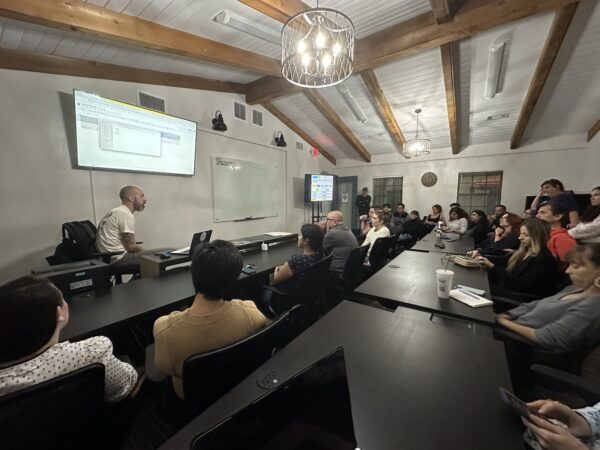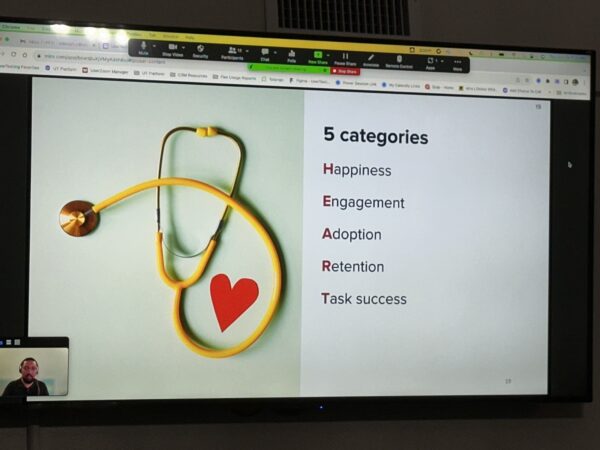
It was a packed house at Computer Coach last Thursday when the Tampa Bay User Experience meetup group gathered for Phil Doughty’s presentation, The ROI of UX.

Here’s the abstract for the event:
Are you trying to start or build a UX practice in your organization? Have you run into a brick wall when trying to get support? Are you constantly trying to “sell” UX to your executive team? Nothing speaks louder than being able to show a return on investment (ROI). In this edition from our UX Fundamentals series, Phil Doughty will show us how we can put UX into terms that make sense to the C-suite; dollars and cents.
For about an hour, Phil, a Customer Success Manager at UserTesting, led the group through his presentation showing how to speak the language of stakeholders in order to convince them of the necessity and value of UX in software and services. He was assisted by his coworker Christian Knebel (also a Customer Success Manager), who teleconferenced in from Dallas.
In the end, Phil argues, you have to account for stakeholder needs. When talking to the C-suite, that often boils down to dollars and cents. You need to convince them that good UX either…
- Increases the money you make, or
- Decreases the money you spend.

Phil spent a fair bit of time on Google’s HEART framework. It’s a powerful tool tailored for UX teams, empowering them to prioritize and enhance distinct facets of the user experience, while also enabling the establishment of clear objectives and user experience metrics to measure their achievements.
HEART, as the acronym suggests, is made up of five key elements, each representing a different aspect of user experience measurement:
- Happiness: This element gauges user satisfaction and overall happiness with the product or service. It often involves surveys or feedback mechanisms to assess user sentiment.
- Engagement: Engagement measures how actively users interact with the product. It can involve tracking metrics like the number of visits, time spent, or specific user actions within the application.
- Adoption: This aspect focuses on user acquisition and the rate at which new users are embracing the product. It assesses how effectively the product is attracting and onboarding new users.
- Retention: The rate at which users continue to use the product over time. It helps assess whether the product is successful in retaining its user base and preventing churn.
- Task Success: A measure of how efficiently users can complete specific tasks within the product. You can measure this by tracking success rates, error rates, or task completion times to identify usability issues.
HEART’s five elements collectively provide a comprehensive framework for evaluating and improving the user experience of a digital product or service. You can apply them to a single feature in your software or service — or ideally, to the whole thing.
If there was one slide that everyone should have taken a picture of, it’s the one above — Metrics vs. KPIs. This makes it clear:
- A metric is a qualitative measurement of how your product, service, and experience, and specific initiatives are performing.
- A KPI — short for key performance indicator — is a kind of metric that measures critical, organization-wide business outcomes that reflect that oragnization’s goals and vision, typically from a financial perspective.
For example, an ecommerce site’s conversion rate — the percentage of website visitors who take a specific action, such as making a purchase — would be a metric, but it wouldn’t be a KPI.
However, that site’s monthly revenue growth — the increase in revenue from one month to the next — is a metric that also qualifies as a KPI. It’s a KPI because it reflects the site’s core business objective: to increase revenue over time.
Typically, a free meetup will get half the people who registered to actually show up, but this one was different — we had a packed room, and it appeared that at least two thirds of the registrants were there! It looks like the result of interesting presentations and an involved, active tech scene.
The Tampa Bay User Experience group has these upcoming events:
- TBUX Lite: Virtual Coffee Talk (online) — Friday, October 27
- TBUX Lite: Virtual Coffee Talk (online) — Friday, November 10
- 2023 Year in Review (in-person) — Wednesday, November 15 @ Radius Church in St. Pete
- TBUX Lite: Virtual Coffee Talk (online) — Friday, November 24
The post Scenes from the Tampa Bay UX Meetup (Thursday, October 19, 2023) appeared first on Global Nerdy.
























